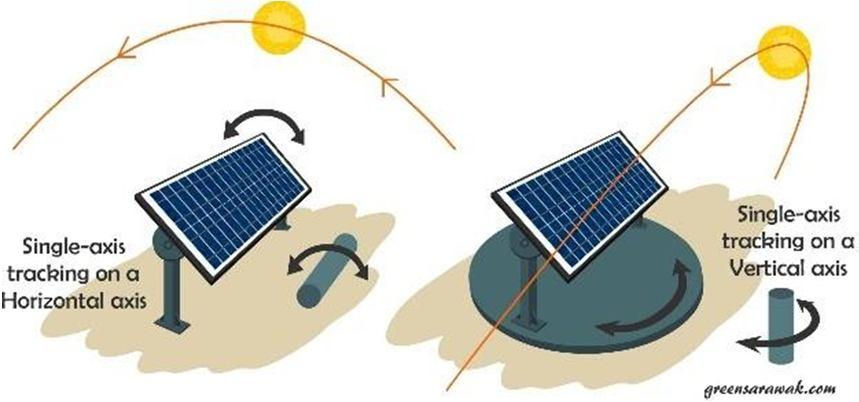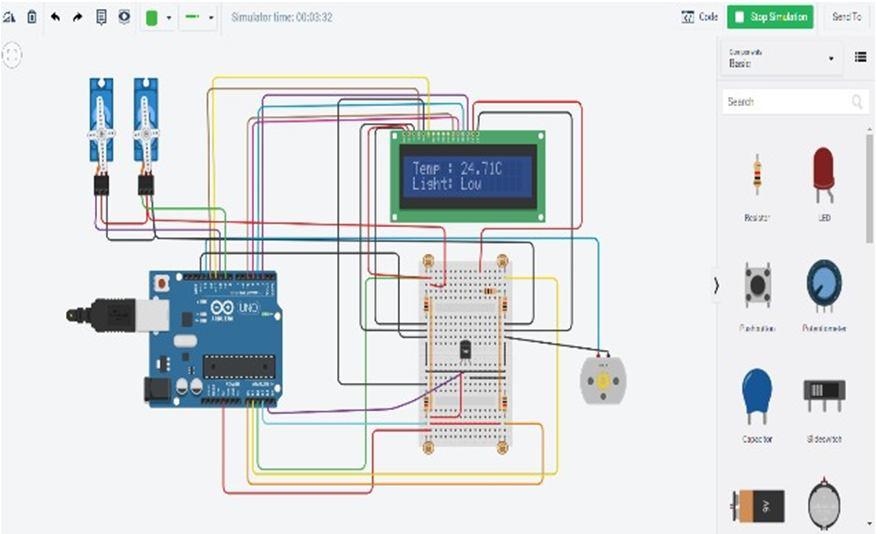
ISSN: 2321 9653; IC Value: 45.98; SJ Impact Factor: 7.538 Volume 10 Issue XI Nov 2022 Available at www.ijraset.com


ISSN: 2321 9653; IC Value: 45.98; SJ Impact Factor: 7.538 Volume 10 Issue XI Nov 2022 Available at www.ijraset.com
Abstract: The objective of our solar tracker is to make it possible to automatically follow the position of the Sun. It can also adjust the orientation of the solar panels according to the Sun's position. This solar tracker system will help you to maximize the energy output of your solar panels by moving them perpendicular to the Sun. More energy than solar panels which are used without the tracking system.
As we understand sun is plentiful source ofpower from that we can effortlessly achievesolar strength with the assist of solar photovoltaic cells. And this photovoltaicimpact converts solar power into electrical power. So, to use this sun energy extra successfully we used sun tracker which canmodify their function according to solar andmake route perpendicular to the sun. Solar tracker offers the low fee device through software primarily based answers. One of the principle boundaries that face theoperation of photovoltaic panels (PV) is overheating because of immoderate solar radiation and excessive ambient temperatures. For preventingoverheattherecan be a temperature cooling gadget.
The subject of solar tracking systems is thesubject of extensive investigation. The material was discussed in the suggestedsystem's study.
This article provides some data on solar modules that are on the market. A few commercially available solar modules have efficiency levels that are more than 22% and possibly even 24%. There are limits tohow much power one solar module cangenerate, so most setups use many modules. In the current effort, an Arduino solar tracker was created and built. On the photovoltaic cell panel, LDR light sensors were employed to measure the solar light's occurrence and intensity.
The amount of solar energy collected by solar systems that follow the sun's trajectories throughout the day is much higher, and as a result, they produce much more power. The main categories of sun tracking systems created over the previous 20 years have been reviewed in thisresearch. According to their mode of rotation, ithas been demonstratedthatthesesun tracking systems can be genericallycategorised as single axis and dual axis.
This paper presents a design concept for a solar tracking system based on the ArduinoUNO that allows solar panels to be moved in the direction of the most sun light incidence. As a result, we get a more effective system that is small, affordable, and simple to use. When compared to solarmodules at a fixed angle, the usage of solartrackers can improve electricity generationby around a third, and some claim by as much as 40% in some climates. And a dualaxis tracking system that can move the panel in the direction of the most solar lightincidence while sensing the solar light that strikes it.

The study makes it clear that adding solar trackers will undoubtedly boost theeffectiveness of SPV systems, but careful installation of solar trackers with these systems is necessary. Solar photovoltaic systems are used to capture solar energy, but because the earth rotates around the sun, solar energy in present solar panels is only available for a certain portion ofthe day. Solar trackers areused to solve this issue.

ISSN: 2321 9653; IC Value: 45.98; SJ Impact Factor: 7.538 Volume 10 Issue XI Nov 2022 Available at www.ijraset.com


An ATmega328P microcontroller was usedin the system to direct the motion of two servo motors, which rotated the solar panelin two axes. The microprocessor calculatedthe rotational speed based on data gatheredfrom four photo sensors placed close to thesolar panel. An operational solar tracking system was created and put into use at the project's conclusion. It was able to repeatedly position the solar panel with thesun or any other source of light. The designof the solar tracker can be used as a model and a jumping off point for the creation of more sophisticated systems in the future.

1) A solar tracker is a tool that orients a solar panel closer to the Sun.
2) The reason of a monitoring mechanism is to follow the solar asit moves across the sky.
3) Trackers are used to limit theperspective of prevalence between the incoming sunlight and aphotovoltaic panel.
4) Reducing this perspective increasesthe amount of power produced.
5) There are important forms of sun trackerstobehadwithinthemarket:unmarried axis and twin axis.
1) Single axis trackers have one axisof movement
2) It rotates on an unmarried point.
3) Single axis trackers willaccumulate less power.

4) Less performance.
1) Dual axis trackers have two axes ofmotion
2) It rotates on two factors.
3) Dual axis trackers will gather morepower
4) It’s high priced.
5) More efficiency.
1) Overheating reduces theperformance of the panelsdramatically.
2) Temperature is the critical issue to acquire maximum efficiency.
3) For enhancing efficiency of solarpanel device temperature cooling device is required.
4) The temperature ought to be maintained low through cooling it down throughout its operation length.
ISSN: 2321 9653; IC Value: 45.98; SJ Impact Factor: 7.538 Volume 10 Issue XI Nov 2022 Available at www.ijraset.com

1) Take mini breadboards, vicinity them for this reason and connect power and ground deliver to them from Arduino. 2) Place four ldr’s at the breadboards for that reason. 3) Connect one pole of all ldr’s to Arduino and equal pole to ground the usage of resistor and other pole to the power deliver. 4) Place a temperature sensor on breadboard and join that to ground, energy supply and Arduino. 5) Connect 2 servo and 1 dc motor to Arduino. 6) Also be a part of an LCD for that reason just so it may display temperature and mild depth. 7) Write code as a consequence.



1) Intensity of sun electricity era will increase because of direct publicityto daylight.
Solar Trackers are clean to evolve and flexible for set up.
Solar trackers generate greater electricity in roughly the equalquantity of space wanted for constant tilt structures, making them perfect for optimizing land utilization.
Advancement in technology and reliability in electronics andmechanics have extensivelydecreased long term maintenance concerns for tracking system.
1) Improving the mechanical structure. 2) Increasing the burden carrying ability and placing a sun panel with the whole gadget.
Adjusting the tools ratio to save you power loss.
Slowing down the fee of rotation while there's no want of power to save you wear and tear of the gadget.
Reducing the price of mechanical structure.
ISSN: 2321 9653; IC Value: 45.98; SJ Impact Factor: 7.538 Volume 10 Issue XI Nov 2022 Available at www.ijraset.com

1) The invention of Solar Tracking System helps us enhance the performance of PV sun machine in an easy and green way.
2) Using of alternative ideology of sunlight power.
3) Established a model of automatic monitoring gadget to preserve vertical touch among solar panels and daylight.
4) Improved the utilitycharge of sunelectricity and efficiency of solar power era structures.
[1] Ashish Yadav, Pritam Makwana,” Solar Tracking System Using Arduino”,inFebruary 2018
[2] Suneetha Racharla1, K Rajan,” Solar Tracking System A review”, January2016
[3] Jyoti Mishra, Ritula Thakur, Alok Deep.” Arduino based Dual Axis SmartSolar Tracker”,2017.
[4] “A Review Paper on Solar Tracking System for Photovoltaic Power Plant”, February 2020.
[5] Debasis Kumar Das, Sourav Basak,” DUAL AXIS SOLAR TRACKER”,2018.
[6] https://rcciit.org/students_projects/projects/ee/2018/GR1.pdf

[7] https://www.academia.edu/35861133/A_Seminar_project_report_ARDUINO_BASE D_SOLAR_TRACKING_SYSTEM

[8] https://www.ijser.org/researchpaper/Solar Tracking System Using Arduino.pdf

